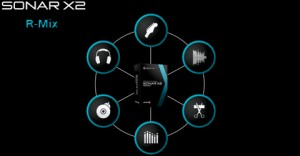 I will never forget witnessing a demonstration of R-MIX software for the first time. Fast-forward a bit, and I will also never forget being in a meeting where I discovered that R-MIX was going to be incorporated into SONAR X2 Producer. Music production light-bulbs started going off in my head imagining what I was going to be able to do with multiple instances of R-MIX inside SONAR (see video below.)
I will never forget witnessing a demonstration of R-MIX software for the first time. Fast-forward a bit, and I will also never forget being in a meeting where I discovered that R-MIX was going to be incorporated into SONAR X2 Producer. Music production light-bulbs started going off in my head imagining what I was going to be able to do with multiple instances of R-MIX inside SONAR (see video below.)
Technically speaking it is an audio manipulation plugin that is powered by Roland’s newly developed V-Remastering technology in conjunction with VariPhrase — lets you see the components of a stereo mix as color-coded clouds of energy and harmonic matter as the track plays. Speaking as a musician, the only way I can describe it is by calling it “visual sound,” and it is truly impressive as well as creative.
What can you do with R-MIX?
There are many interesting things you can do with R-MIX SONAR. You can create “minus-one” type mixes from a stereo track to get rid of the lead vocals. You can isolate instrumentation or elements within a stereo track and manipulate the sound further. You can isolate vocals in a stereo mix. You can use R-MIX’s onboard FX to further manipulate an isolated part. Another great use is the ability to clean up old recordings or get rid of noise in a track; such as an air conditioning unit in another room that a sensitive mic/preamp has picked up.
For me, I’ve had a blast using R-MIX for the last two weeks as a sonic-generator. I’m able to get unique cutting edge sounds out of this plugin that are different from anything I have heard or used before. The fact that all the parameters are automatable (see video) is key; and to further my point, setting it into an effects chain with other plugins where multiple parameters can be controlled by individual knobs makes this a no-brainer for someone looking to stir the pot with unlimited possibilities of sound creation.
What are the components to R-MIX?
 Field View: this is the visual scope which shows you the sound. It combines frequencies with velocities throughout the stereo field.
Field View: this is the visual scope which shows you the sound. It combines frequencies with velocities throughout the stereo field.
 Effect: R-MIX allows you to isolate the desired sound, and then add 1 of 8 available effects. There is a depth slider which is nice for more subtle tones, or you can heavily manipulate the isolated audio.
Effect: R-MIX allows you to isolate the desired sound, and then add 1 of 8 available effects. There is a depth slider which is nice for more subtle tones, or you can heavily manipulate the isolated audio.
 Noise Cancel: Here is a section which offers 4 modes to help you restore audio or get rid of unwanted noise. Each mode has a different benefit depending on your source (Hiss, Hum, Wind, Air conditioner.)
Noise Cancel: Here is a section which offers 4 modes to help you restore audio or get rid of unwanted noise. Each mode has a different benefit depending on your source (Hiss, Hum, Wind, Air conditioner.)
 Shape: This gives you the option to target audio with a rounded scope (circle/oval = softer effect,) or a more angled scope (square/rectangle = sharper effect).
Shape: This gives you the option to target audio with a rounded scope (circle/oval = softer effect,) or a more angled scope (square/rectangle = sharper effect).
 Inside Level: This is the level of the audio within the scope.
Inside Level: This is the level of the audio within the scope.
Inside Pan Knob: This allows you to take the isolated sound within the scope and move the panning.
Outside Level: This is the level of the audio outside of the scope.
Outside Pan Knob: This gives you the ability to move the audio on the outside of the scope to different areas of the stereo field.
Bypass: Bypasses the plugin.
In conclusion, I have to say that this is an amazing addition to SONAR’s arsenal. There are so many different things you do with R-MIX and they are all very unique. There’s no right or wrong, you simply place it on a track and use your ear to come up with some very interesting sounds.
As a noise reduction tool, it’s amazing. As you will see and hear in the video, I was able to take the hiss out of one side of a track where the mic pre and compressor were cranked and had picked up air conditioning noise.
![]() Regardless of what you use it for, you will find it interesting, functional and fun to use.
Regardless of what you use it for, you will find it interesting, functional and fun to use.
Learn more about New Features in SONAR X2 or Buy SONAR X2 Producer today.



3 Replies to “SONAR X2 Feature Peek: R-MIX SONAR (Video)”
Comments are closed.